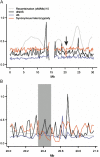Genomic determinants of protein evolution and polymorphism in Arabidopsis
- PMID: 21926095
- PMCID: PMC3296466
- DOI: 10.1093/gbe/evr094
Genomic determinants of protein evolution and polymorphism in Arabidopsis
Abstract
Recent results from Drosophila suggest that positive selection has a substantial impact on genomic patterns of polymorphism and divergence. However, species with smaller population sizes and/or stronger population structure may not be expected to exhibit Drosophila-like patterns of sequence variation. We test this prediction and identify determinants of levels of polymorphism and rates of protein evolution using genomic data from Arabidopsis thaliana and the recently sequenced Arabidopsis lyrata genome. We find that, in contrast to Drosophila, there is no negative relationship between nonsynonymous divergence and silent polymorphism at any spatial scale examined. Instead, synonymous divergence is a major predictor of silent polymorphism, which suggests variation in mutation rate as the main determinant of silent variation. Variation in rates of protein divergence is mainly correlated with gene expression level and breadth, consistent with results for a broad range of taxa, and map-based estimates of recombination rate are only weakly correlated with nonsynonymous divergence. Variation in mutation rates and the strength of purifying selection seem to be major drivers of patterns of polymorphism and divergence in Arabidopsis. Nevertheless, a model allowing for varying negative and positive selection by functional gene category explains the data better than a homogeneous model, implying the action of positive selection on a subset of genes. Genes involved in disease resistance and abiotic stress display high proportions of adaptive substitution. Our results are important for a general understanding of the determinants of rates of protein evolution and the impact of selection on patterns of polymorphism and divergence.
Figures



Similar articles
-
Rates and patterns of molecular evolution in inbred and outbred Arabidopsis.Mol Biol Evol. 2002 Sep;19(9):1407-20. doi: 10.1093/oxfordjournals.molbev.a004204. Mol Biol Evol. 2002. PMID: 12200469
-
Selection on amino acid substitutions in Arabidopsis.Mol Biol Evol. 2008 Jul;25(7):1375-83. doi: 10.1093/molbev/msn079. Epub 2008 Apr 4. Mol Biol Evol. 2008. PMID: 18390851 Free PMC article.
-
DNA polymorphism at the FRIGIDA gene in Arabidopsis thaliana: extensive nonsynonymous variation is consistent with local selection for flowering time.Mol Biol Evol. 2002 Aug;19(8):1261-71. doi: 10.1093/oxfordjournals.molbev.a004187. Mol Biol Evol. 2002. PMID: 12140238
-
The Genetics Underlying Natural Variation in the Biotic Interactions of Arabidopsis thaliana: The Challenges of Linking Evolutionary Genetics and Community Ecology.Curr Top Dev Biol. 2016;119:111-56. doi: 10.1016/bs.ctdb.2016.03.001. Epub 2016 Apr 23. Curr Top Dev Biol. 2016. PMID: 27282025 Review.
-
Determinants of DNA sequence divergence between Escherichia coli and Salmonella typhimurium: codon usage, map position, and concerted evolution.J Mol Evol. 1991 Jul;33(1):23-33. doi: 10.1007/BF02100192. J Mol Evol. 1991. PMID: 1909371 Review.
Cited by
-
A neutrality test for detecting selection on DNA methylation using single methylation polymorphism frequency spectrum.Genome Biol Evol. 2014 Dec 23;7(1):154-71. doi: 10.1093/gbe/evu271. Genome Biol Evol. 2014. PMID: 25539727 Free PMC article.
-
Strong evidence for the adaptive walk model of gene evolution in Drosophila and Arabidopsis.PLoS Biol. 2022 Sep 13;20(9):e3001775. doi: 10.1371/journal.pbio.3001775. eCollection 2022 Sep. PLoS Biol. 2022. PMID: 36099311 Free PMC article.
-
Purifying selection enduringly acts on the sequence evolution of highly expressed proteins in Escherichia coli.G3 (Bethesda). 2022 Nov 4;12(11):jkac235. doi: 10.1093/g3journal/jkac235. G3 (Bethesda). 2022. PMID: 36073932 Free PMC article.
-
Genomic analyses of a livestock pest, the New World screwworm, find potential targets for genetic control programs.Commun Biol. 2020 Aug 4;3(1):424. doi: 10.1038/s42003-020-01152-4. Commun Biol. 2020. PMID: 32753684 Free PMC article.
-
The Impact of Protein Architecture on Adaptive Evolution.Mol Biol Evol. 2019 Sep 1;36(9):2013-2028. doi: 10.1093/molbev/msz134. Mol Biol Evol. 2019. PMID: 31147689 Free PMC article.
References
MeSH terms
Substances
LinkOut - more resources
Full Text Sources

